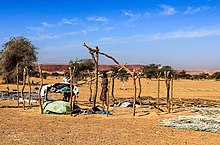Tikkit


The Tikkit ( Berber / Hassania ), DMG tīkkīt, Pl . tīkkatān , is a simple hut made of straw, twigs or crippled wood in the areas of Mauritania shaped by the Arab culture . The often round accommodations can be found sporadically in the entire Sahara region of the country in the gardens of date palm oases and in larger numbers in the northern Adrar region.
The Berber -arabische Bidhan -Bevölkerung lived until the independence of Mauritania in 1960 almost exclusively in tents in Arabic Khaimas ( Haima, Pl. Hiam are called). The nomads traveled with camels and goats in search of patches of pastureland in the desert. At around a dozen oases , compact trading centers arose in the Middle Ages with clay-plastered houses made of rubble stones, between which narrow alleys run. Other oases were and will only become a tent camp and meeting place for the plantation owners during the date harvest, which coincides with the start of the rainy season in July. The rest of the year once lived only its tributaries ( Hassania Pl. Znāga, Sg . Znāgī or Pl. Lahma , Sg. Lahmi ) and slave (Pl. Abid, Sg. Abd ) as field workers in the oasis. Their tikkits were inside the palm trees. The present-day village, located in the Almoravid ruins of Azougui , expands every year in the hot summer months when the families from the city who have come to harvest the dates build tikkits. In addition to tents and stone houses, these semi-mobile homes form a third type of traditional accommodation in Mauritania.
The Imraguen (Pl. Imrāgen, Sg. Amrig ) are traditional fishermen on the Atlantic coast. They belong to the lowest social class within the Mauritanian class society and live in small groups far away from the roads between Nouakchott and Nouadhibou in tents or in modest huts that they build on the sand dunes. Their huts consist of sea grasses (zostera) and some flotsam.
Tikkits can come in very different forms. Often they are conical round huts with a tree trunk as a central support, the construction of which goes back to black African influences. Other huts form a regular round dome. Elongated huts with barrel roofs are rarer . A few kilometers north of Atar is the Laouena settlement with several dozen dome-shaped tikkits. Date palm leaves or branches of tamarinds (f. Agānāte, tāgāna , Pl. Agānāt ) are used for construction. The grasses, leaves or pieces of wood are held together with cords made from baobab bark fibers (Sg. F. Teīdume , Pl. Teidum ).
Primitive huts are commonly called gourbi in French-speaking North Africa . The Tukul in Ethiopia and South Sudan are not huts, but round houses with solid walls and a conical thatched roof.
literature
- Wolfgang Creyaufmüller: Nomad culture in the Western Sahara. The material culture of the Moors, their handicraft techniques and basic ornamental structures. Burgfried-Verlag, Hallein (Austria) 1983, pp. 434, 745
Individual evidence
- ^ World Heritage List. Nominations 2005. (PDF; 11.4 MB) UNESCO, p. 53
- ↑ Alfred G. Gerteiny: Mauritania. Pall Mall Press, London 1967, p. 174
- ↑ gourbi-foto tenes.info Early colonial photo of a straw hut (gourbi) near Tissemsilt (formerly Vialar) in the northern Algerian province of the same name
- ↑ Abdallah Ould Khalifa: La region du Tagant en Mauritanie. L'oasis de Tijigja between 1660-1969. Karthala, Paris 1999, p. 268 (online at Googlebooks)
- ↑ Abera Kumie, Yemane Berhane: Crowding in a traditional housing (“Tukul”) in Ethiopia. ( Memento of March 4, 2016 in the Internet Archive ) In: Ethiopian Journal of Health Development, 2002

